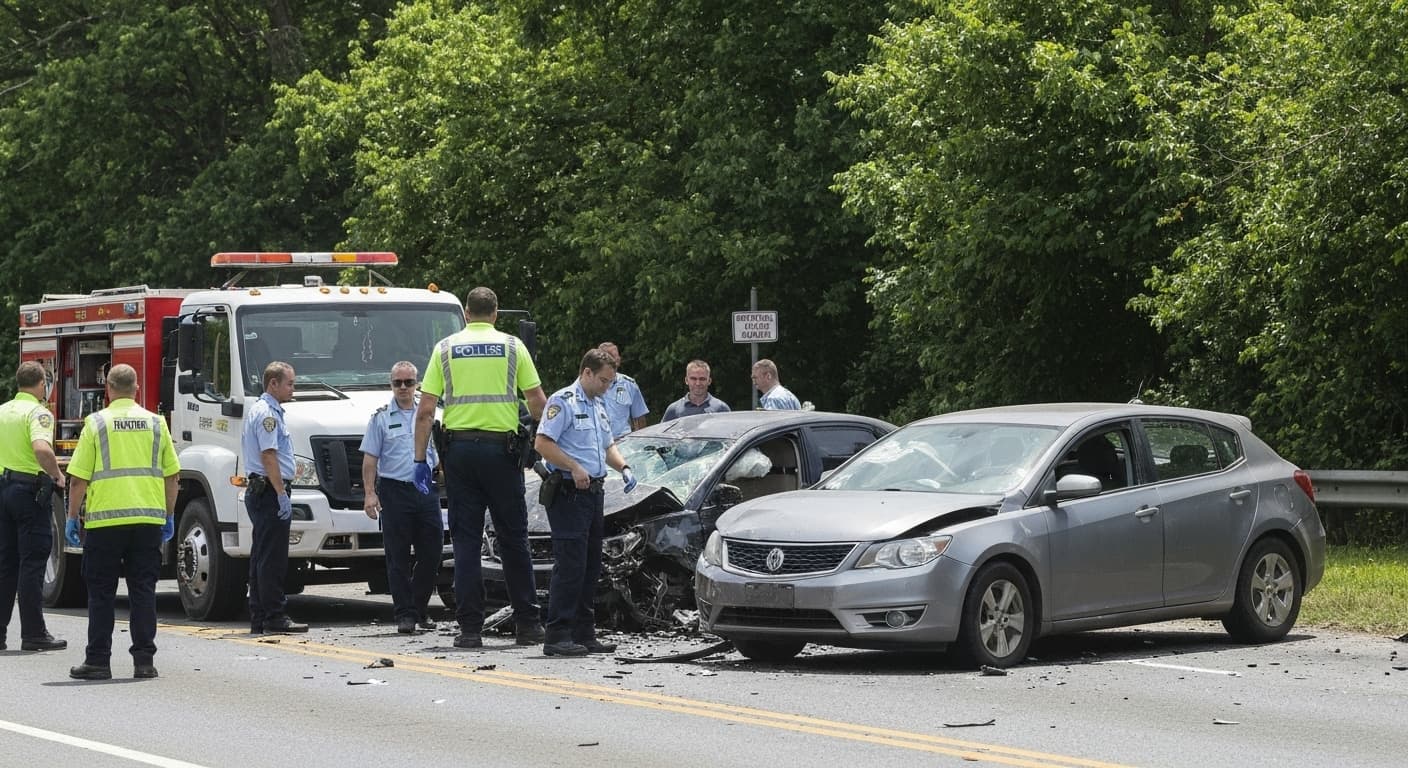
7 Signs It's Time for Elderly Drivers to Stop Driving
Learn about 7 signs it's time for elderly drivers to stop driving and how it affects your legal rights after a car accident. Get expert advice from experienced car accident attorneys.
# 7 Signs It's Time for Elderly Drivers to Stop Driving
The decision about when elderly drivers should stop driving is deeply personal and often challenging for both seniors and their families. While there is no universal age when all elderly drivers should stop driving, certain signs and indicators can help determine when driving has become unsafe. Understanding these warning signs and knowing how to approach this sensitive topic can help ensure safety while maintaining dignity and independence for as long as possible. An experienced elder care professional or driving specialist can provide objective assessments and guidance during this transition.
1. Increased Frequency of Traffic Violations
A sudden increase in traffic tickets, warnings, or citations often indicates declining driving skills and judgment.
Warning Signs to Watch For:
- Multiple speeding tickets within a short time period
- Frequent warnings for improper lane changes or signaling
- Citations for running stop signs or red lights
- Parking violations or difficulty with parking regulations
- Complaints from other drivers about driving behavior
What This Indicates:
- Reduced attention to traffic rules and regulations
- Slower reaction times to traffic signals and signs
- Difficulty maintaining proper lane positioning
- Impaired ability to judge safe following distances
2. Near-Miss Incidents and Close Calls
Experiencing more frequent near-miss accidents or close calls suggests that reaction times and judgment are declining.
Common Near-Miss Scenarios:
- Almost hitting pedestrians or cyclists
- Close calls at intersections or driveways
- Near collisions when changing lanes
- Difficulty merging onto highways or busy roads
- Problems with roundabouts or complex traffic patterns
What This Indicates:
- Reduced peripheral vision and situational awareness
- Slower processing of multiple traffic inputs
- Difficulty anticipating other drivers actions
- Impaired depth perception and distance judgment
3. Difficulty with Night Driving
Struggling with night driving is often one of the earliest signs that driving skills are declining.
Night Driving Challenges:
- Difficulty seeing road signs and lane markings at night
- Problems with oncoming headlights causing glare
- Reduced ability to judge distances in low light conditions
- Increased anxiety or avoidance of evening driving
- Getting lost more easily when driving after dark
What This Indicates:
- Age-related vision changes affecting night vision
- Cataracts or other eye conditions reducing visual acuity
- Slower adaptation to changing light conditions
- Increased susceptibility to distractions at night
4. Getting Lost in Familiar Areas
Becoming lost or disoriented in previously familiar areas is a significant safety concern.
Navigation Problems:
- Difficulty finding familiar routes or destinations
- Getting turned around in known neighborhoods
- Problems with highway exits or landmark recognition
- Increased reliance on GPS or detailed directions
- Panic or confusion when routes change unexpectedly
What This Indicates:
- Possible early cognitive changes or memory issues
- Reduced spatial orientation and direction sense
- Difficulty processing complex visual information
- Increased vulnerability to stress and confusion
5. Physical Changes Affecting Vehicle Control
Physical limitations that make it difficult to safely operate a vehicle indicate it may be time to stop driving.
Physical Control Issues:
- Difficulty turning the head to check blind spots
- Struggles with steering wheel manipulation
- Challenges with accelerator and brake coordination
- Pain or discomfort while driving extended periods
- Reduced strength for emergency maneuvers
What This Indicates:
- Arthritis or joint problems limiting mobility
- Reduced muscle strength and coordination
- Neck stiffness from previous injuries or age
- Increased fatigue and reduced stamina
6. Family and Friend Concerns
When family members, friends, or neighbors express consistent concerns about driving safety, it should be taken seriously.
External Concerns:
- Family members noticing driving errors or close calls
- Friends being hesitant to ride with the driver
- Neighbors reporting concerning driving behaviors
- Passengers experiencing anxiety while riding
- Multiple people independently raising safety concerns
What This Indicates:
- Objective observations confirm driving safety issues
- Others perceive driving ability as compromised
- Independent validation of declining skills
- Social awareness of safety problems exists
7. Driving-Related Anxiety or Avoidance
When driving becomes a source of significant stress, anxiety, or avoidance, it may indicate declining ability.
Behavioral Changes:
- Avoiding certain driving situations or times
- Increased anxiety before or during driving
- Preference for having a passenger accompany rides
- Limiting driving to familiar, low-traffic areas only
- Getting frustrated or upset while driving easily
What This Indicates:
- Unconscious recognition of declining abilities
- Increased mental strain from driving tasks
- Reduced confidence in driving skills
- Self-awareness of safety limitations
Medical and Professional Assessments
Physician Consultation Importance
Regular medical evaluations can provide objective insights into driving fitness and retirement timing.
Medical Assessment Components:
- Vision and hearing screening evaluations
- Cognitive function and memory testing
- Physical coordination and reaction time assessment
- Medication impact on driving ability review
- Chronic condition management affecting safety
Physician Recommendations:
- Age-related driving capability discussions
- Referral to driving rehabilitation specialists
- Medication adjustment recommendations
- Alternative transportation option suggestions
Professional Driving Evaluations
Occupational Therapy Assessments
Professional driving evaluations can provide comprehensive assessments of driving fitness.
Evaluation Components:
- Behind-the-wheel driving performance assessment
- Cognitive and functional ability testing
- Vehicle modification need determination
- Safety concern identification and recommendations
- Compensation strategy development for limitations
Assessment Outcomes:
- Conditional driving recommendations with restrictions
- Vehicle adaptation suggestions for continued driving
- Complete driving cessation recommendations
- Alternative transportation transition planning
Alternative Transportation Options
Public Transit and Ride Services
Various transportation alternatives can maintain independence and access to essential services.
Public Transportation Options:
- Fixed-route bus and light rail systems
- Paratransit services for eligible individuals
- Volunteer driver programs for seniors
- Community transportation service organizations
- Medical transportation providers for appointments
Modern Transportation Solutions:
- Rideshare services like Uber and Lyft
- Door-to-door transportation services
- Community senior transportation programs
- Family and friend transportation networks
- Subscription-based transportation services
Planning for Driving Cessation
Gradual Transition Approach
A phased approach to driving retirement can make the transition smoother and less stressful.
Transition Phases:
- Limit driving to essential trips only
- Avoid challenging driving conditions and times
- Establish regular alternative transportation usage
- Practice using public transit and ride services
- Update personal transportation emergency plan
Support System Development:
- Identify and train backup drivers from family/friends
- Establish relationships with transportation providers
- Create emergency transportation contact list
- Plan for mobility assistance equipment needs
- Develop contingency plans for various scenarios
Emotional and Psychological Support
Managing the Transition Emotionally
Driving cessation can trigger feelings of loss of independence and changes in self-image.
Emotional Support Strategies:
- Acknowledge and validate feelings about driving cessation
- Focus on maintaining overall independence and mobility
- Explore new activities and social opportunities
- Seek counseling support for adjustment challenges
- Celebrate successful adaptation to new transportation methods
Maintaining Self-Esteem:
- Emphasize that driving cessation is a responsible choice
- Highlight continued contributions and capabilities
- Focus on personal growth and new experiences
- Maintain social connections and community involvement
- Celebrate the wisdom of prioritizing safety
Legal and Financial Considerations
Insurance and Registration Updates
Properly handling vehicle ownership and insurance changes after driving cessation.
Insurance Considerations:
- Policy modification notifications for non-driving status
- Insurance cost reduction options for stored vehicles
- Surrender of license paperwork completion
- Vehicle storage and registration change procedures
Vehicle Ownership Options:
- Vehicle sale or donation arrangements
- Extended storage agreements and costs
- Registration transfer or suspension procedures
- Title transfer documentation completion
Family Communication Strategies
Sensitive Discussion Approaches
Approaching driving cessation conversations with empathy and understanding.
Communication Techniques:
- Express concerns using I statements and specific examples
- Emphasize safety and love rather than criticism
- Focus on working together to find solutions
- Listen actively to concerns and feelings expressed
- Involve elder in decision-making process when possible
Professional Mediation Support:
- Family counseling session arrangements
- Professional mediator involvement consideration
- Driving specialist consultation for objective assessment
- Community elder care service referrals
- Legal guardianship discussion if cognitive issues exist
Ongoing Independence Maintenance
Life Engagement Activities
Maintaining active, purposeful living through alternative activities and social engagements.
Alternative Activities:
- Walking clubs and senior fitness programs
- Community center classes and workshops
- Volunteer opportunities at local organizations
- Hobby and interest group participation
- Educational course and seminar attendance
Social Connection Opportunities:
- Senior center regular attendance and activities
- Book clubs and discussion group participation
- Exercise classes and wellness program involvement
- Community event and social gathering attendance
- Family gathering and relationship strengthening
Conclusion: Prioritizing Safety and Dignity
The decision to stop driving is one of the most challenging transitions many seniors face, but it represents a responsible choice that prioritizes safety for everyone. Recognizing the seven signs that it may be time to stop driving can help families approach this conversation with empathy, preparation, and practical solutions. With proper planning and support, seniors can maintain their independence and quality of life through alternative transportation options and continued engagement in their communities.
Remember that driving cessation is not a failure but a demonstration of wisdom and responsibility. The focus should be on maintaining dignity, safety, and quality of life for as long as possible through thoughtful planning and supportive alternatives. Professional guidance from physicians, driving specialists, and elder care professionals can provide valuable support during this important transition.


